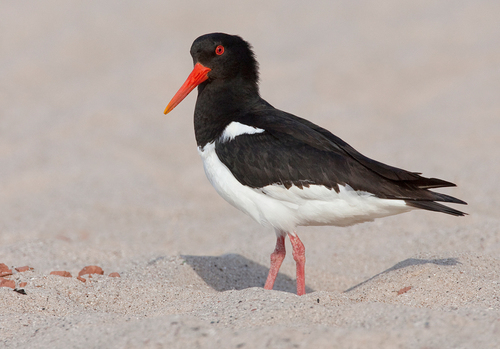
Eurasian Oystercatcher
The Eurasian Oystercatcher (*Haematopus ostralegus*) is a distinctive wading bird, easily recognizable by its black and white plumage, bright orange-red bill, and pink legs. It plays a crucial role in coastal and wetland ecosystems, primarily as a predator of mollusks and other invertebrates. While not globally threatened, some populations face significant pressures from habitat loss and human disturbance. The oystercatcher is a prominent feature of many European coastlines and has some cultural significance, often appearing in folklore and coastal art.
39-44 cm
Length
72-83 cm
Wingspan
Near Threatened
Conservation Status
Distribution
Breeds across Eurasia, from Iceland and the British Isles eastwards to Kamchatka and China. Winters along the coasts of Europe, Africa, the Middle East, and South Asia. Migratory routes vary; some populations are resident, while others undertake long-distance migrations.
Lifespan
Typically 10-15 years in the wild, but can exceed 30 years. One banded individual lived over 40 years.
Eurasian Oystercatcher's Habitat
Habitat Types
Coastal beaches, Rocky shores, Estuaries, Salt marshes, Mudflats, Inland wetlands (during breeding season)
Climate Zones
Temperate, Boreal, Subarctic
Adaptations
Their strong, laterally compressed bill is adapted for prying open or hammering apart shellfish. They possess robust legs for wading in shallow water and navigating rocky terrain.
Variations
Several subspecies are recognized, differing slightly in size and plumage darkness, including *H. o. ostralegus*, *H. o. longipes*, *H. o. buturlini*, and *H. o. osculans*. These subspecies occupy different breeding ranges.
Appearance
Breeding Plumage
Breeding plumage is characterized by a black head, neck, and upperparts, with white underparts and a white wing bar. Non-breeding plumage is similar, but may have a small white patch on the throat.
Seasonal Feather Changes
Limited seasonal variation, mainly a small white throat patch appearing in non-breeding plumage.
Sex Based Plumage Differences
Minimal; females may have slightly browner upperparts, but this is not always discernible.
Notable Features
Bright orange-red bill, Pink legs, Red eyes with a red orbital ring, White wing bar visible in flight
Diet and Feeding
Primary Foods
Mussels, Cockles, Clams, Worms, Crustaceans, Insects (especially during inland breeding)
Foraging Behavior
Uses its specialized bill to either hammer shellfish open or to probe in mud and sand for invertebrates. Foraging occurs during both day and night, often timed with the tides.
Specializations
The bill shape varies slightly between individuals, with some specializing in hammering and others in probing. This reduces intraspecific competition.
Seasonal Diet Variations
Diet shifts towards insects and earthworms when breeding inland, away from coastal food sources.
Behavior
Social Structure
Forms large flocks outside of the breeding season. During breeding, pairs are territorial.
Communication
Loud, piping calls, Wing-clapping displays (during courtship), Alarm calls to warn of predators
Migration
Some populations are migratory, traveling long distances between breeding and wintering grounds. Others are resident or only undertake short-distance movements.
Territorial or Group Behaviors
Defends breeding territories vigorously against other oystercatchers and potential predators. Forms large, non-breeding flocks for roosting and feeding.
Conservation
Threats
Habitat loss (due to coastal development and land reclamation), Human disturbance (at breeding and feeding sites), Pollution (oil spills and chemical contamination), Climate change (sea level rise and altered prey availability), Predation (by introduced mammals and increased populations of native predators)
Protection Programs
Designation of protected areas (e.g., Special Protection Areas under EU Birds Directive), Habitat restoration projects, Monitoring of populations, Awareness campaigns to reduce disturbance
Local National Laws
Protected under various national and international laws, including the Agreement on the Conservation of African-Eurasian Migratory Waterbirds (AEWA).
Population Trend
Decreasing
Population Estimates
Global population estimated at 850,000 - 1,100,000 individuals.
Interesting Facts
They can live for a remarkably long time.
The oldest recorded Eurasian Oystercatcher lived for over 40 years.
Their bill shape can reflect their feeding specialization.
Individuals with blunter bills tend to hammer shellfish, while those with more pointed bills are better at probing for worms.
They are highly adaptable to different foraging habitats.
While primarily coastal, they can also breed inland along rivers and lakes.
They use their strong bills to defend themselves.
The oystercatcher will use their beak as a weapon against predators or rival birds.
Oystercatchers are known for their 'piping' ceremonies.
These are loud and elaborate social interactions that strenghten pair bonds or resolve territorial disputes.
Faqs about Eurasian Oystercatcher
What is an oystercatcher's main food?
Their main food is shellfish, such as mussels and cockles, but they also eat worms, crustaceans, and insects.
Are oystercatchers endangered?
The Eurasian Oystercatcher is currently classified as Near Threatened by the IUCN, meaning it is close to qualifying for a threatened category.
Where do oystercatchers nest?
They nest on the ground, creating a shallow scrape lined with shells or pebbles, usually on beaches, salt marshes, or sometimes inland near lakes and rivers.
How long do oystercatcher chicks stay with their parents?
Chicks are able to walk and feed themselves soon after hatching, but they remain with their parents for several weeks, fledging at around 32-35 days old.
Do oystercatchers migrate?
Some populations migrate long distances, while others are resident or make only short movements depending on food availability and climate.
Copyright @ Nature Style Limited. All Rights Reserved.
 English
English